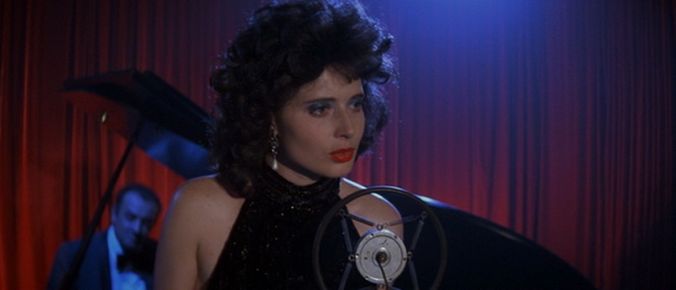 Back to selection
Back to selection
The Blue Velvet Project
Blue Velvet, 47 seconds at a time by Nicholas Rombes
The Blue Velvet Project, #76

Second #3572, 59:32
Back at the Slow Club, Jeffrey has just poured himself a Heineken, and Dorothy has noticed something that has caused a shadow of fear to cross her face. In a subtle relay of looks captured in nine shots that last just over one minute, this happens:
Shot 1: Jeffrey, having poured a Heineken, watches Dorothy perform “Blue Velvet.”
Shot 2: (second #3572, the frame above) Dorothy sees something in the audience that spooks her.
Shot 3: Jeffrey notices Dorothy’s fear, and turns his head to where she is looking.
Shot 4: We see Frank, the object of Dorothy’s gaze, from roughly Jeffrey’s point of view. He sits in the audience bathed in pale blue light.
Shot 5: Jeffrey again, whose eyes move from Frank to Dorothy, in a way that suggests he has just understood something.
Shot 6: A medium shot of Frank, in rapture to Dorothy’s performance, his eyes slowly shutting and then opening, as if moving in and out of a dream.
Shot 7: Back to Jeffrey, who slowly leans forward with concern.
Shot 8: Back to Dorothy, who finishes her rendition, shooting Frank a defiant look as she puts emphasis on the word tears in “And I still can see blue velvet through . . . my . . . tears.”
Shot 9: Frank, as the camera slowly pans down to reveal him holding a swatch of blue velvet in his hands, rubbing it gently with his thumbs.
Unlike the first time at the Slow Club, Jeffrey is alone now, without Sandy. Dorothy is alone, too, but watched: by Jeffrey, by Frank, by the anonymous audience, and by the piano player, his face bathed in a kind of monstrous, carnivalesque blue. It’s as if we have slipped into a horror film, and in this regard Blue Velvet is perhaps closest to Lynch’s other great (though underrated) horror film Twin Peaks: Fire Walk with Me (1992). In her fine book Recreational Terror, Isabel Cristina Pinedo suggests that in the postmodern horror film the
boundary between living and dead, normal and abnormal, human and alien, good and evil, is blurred, sometimes indistinguishable. In contrast to the classical horror film, the postmodern film locates horror in the contemporary everyday world, where the efficacious male expert is supplanted by the ordinary victim who is subjected to high levels of explicit, sexualized violence, especially if female.
And so here, at second #3572, Dorothy holds Frank in her gaze, reversing the roles in an open acknowledgement of her own power, the momentary power than any stage star has over the dumb awe of a fawning audience member which, at this moment, is all that Frank is.
Over the period of one full year — three days per week — The Blue Velvet Project will seize a frame every 47 seconds of David Lynch’s classic to explore. These posts will run until second 7,200 in August 2012. For a complete archive of the project, click here. And here is the introduction to the project.
